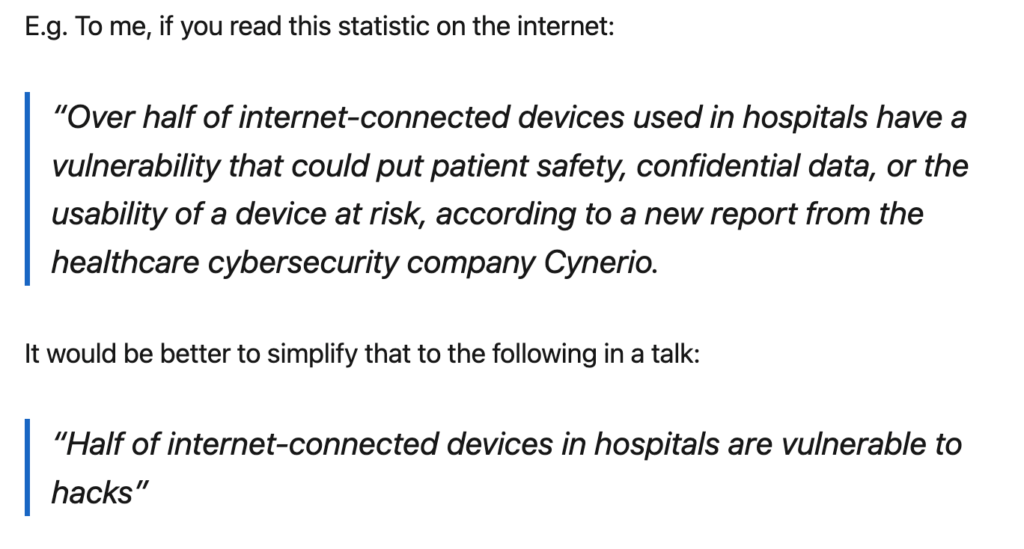6 Proven Ways To Bring Your Points To Life By “Showing, Not Telling”
Ever had anyone say to you “I told you so!” (after you didn’t follow their advice)?
Or ever told someone else that?
If you have, you’ll intuitively get that….
No-one is influenced or inspired to change their behaviour by simply being ‘told’ something.
Also, if you look at all the best TED Talks, they spend most of their time explaining the WHY. That is, showing you (rather than telling you), why their idea matters.
This is backed up by poll I did on LinkedIn a while ago.
I asked people this question — When have you learnt the most in life?
I gave people 4 options:
- Experienced It.
- Reflected on It.
- Were Told It.
- Read It.
About 80% of people responded with 1 – Experienced It, with the remaining 19% on 2 – Reflected On It.
Practically no-one said they read or were told it.
This was not a surprise to me. But it proves that people don’t learn from simply being ‘told’ things.
It reinforces why I always try and show people, rather than tell them the points I’m trying to get across.
Here’s 6 different ways you can show, not tell people……
#1 – A WORKED EXAMPLE
If you’re trying to explain a new process or framework and there’s a way to execute it well, show people a few worked examples.
Showcasing what good vs bad looks like, so people have some boundaries to work within, will ensure people get a very good understanding of how to execute that process well and what to avoid.
Example
I wrote an article a while back about how to make stats in a presentation more interesting (It was called – 11 Ways To Get Eyebrow Raising Stats In Your Presentations).
When I got to a point I was talking about regarding keeping stats short and punchy, I gave a ‘Before vs After‘ type of worked example.
It was a classic case of showing how powerful this tip could be, vs just saying that it’s powerful.
Here’s an excerpt from that Article:

#2 – A VISUAL REPRESENTATION
I’m sure you’re heard the phrase: “A picture paints a thousand words”.
Sometimes our words alone fall short. Whereas a visual representation can quickly convey meaning & relevance.
If we’re trying to explain relationships between multiple aspects or steps in a process, it doesn’t make sense to simply tell people that.
It is much better to share a visual that brings that to life.
Example
Here’s one of my most favourite and memorable uses of Showing Not Telling, using a visual representation / image.

#3 – A STORY
Stories bring to life things that are technical or complex in nature.
They also prove something is the case. They’re the reason why a lot of us will go to the reviews section for a product/service we’re wanting to buy. To check that they company’s claims are in fact true.
So, stories are one of the best ways to prove your point and show don’t tell.
Example
One of the points I regularly make in my Captivating Storyteller Group Program is that stories are far more memorable than facts and figures.
Now if I simply told people that, they ‘might’ believe me, but if it’s not internalised, it’s not as convincing, nor will it stick in people’s minds.
So, instead I tell a story.
I tell the story of when I used to run the Toastmasters Club for the company I was working for (back when I still worked for a corporate). We always wanted to attract new members and also keep our current members engaged and inspired.
So we decided to get some of the execs from our company to join us as a guest speaker every few months. To share their speaking journey and any tips they had on how to become a better speaker.
We invited execs from all across the company, in various roles. They were all very interesting and shared great tips with us. But the only one I can remember in enough detail 10 years later is the one who shared a simple tip with us, with a story wrapped around it.
#4 – A VIDEO
Another interesting way to show people vs tell them, is by mixing up the format it’s packaged in and sharing a video.
It’s not about sharing a video for the sake of it though, it’s about using a video to bring a point to life in a more interesting way than your words alone could.
I share videos in my Powerful Presenter or Captivating Storyteller Group Coaching Sessions. I also share videos in my Corporate Group Workshops. As I know they bring in an additional element and people also tell me afterwards that one of the things they loved the most was the video I shared.
Obviously, you have to be selective and find a great video to use. But when you do, that’s when the magic happens!
Example
I remember listening to a talk at a Conference on Password Hygiene. They were talking about people’s choice of passwords and how easily people can be socially engineered.
However, it wasn’t until they shared a really interesting video where people were interviewed on the streets of America, about what their passwords were. Every single person ended up being convinced to share their password.
Here’s that exact video, if you’re curious to watch it.
#5 – A PROP / DEMO
If you’re telling people about something and that something exists in the physical world, bring that object / thing in!
Just like in the TV Show Shark-Tank, where people pitch products to investors for funding.
People love to be able to see, feel and experience things. It truly brings your message to life!
If what you’re talking about is a digital tool, Demo the tool so people can see/experience it in action.
Example
I’ve been in the audience at a Technical Conferences where someone was talking about a AI-Based Facial Recognition door-bell they had made. The really cool part of their talk was when they showed it in action on the stage.
I’ve also been to many Security Conferences, where people have showcased techniques such as collecting sensitive information from people online live, or hacking into services live.
Live demos can be a little risky though, so always have a pre-recorded option as a backup, in case it doesn’t work as expected on the day.
#6 – AN EXERCISE
An alternative to telling people about something is to get them involved in a fun game or exercise.
Exercises = Experiential Learning, which is learning through DOING, as opposed to learning through LISTENING.
Apparently, we retain 75% of what we do, as opposed to 5% of what we hear.
That is why the concept of experiential learning is a great way to engage and teach an audience.
Example
E.g. In my Powerful Presenter Sessions, when I want to make the point that people can’t remember lots of discrete information, I don’t simply tell them this, or try to just explain why this is this case. I back it up with a fun game.
I play a memory game with them that involves flip cards. It proves my point in a far more engaging and memorable way than if I simply told them.
IN SUMMARY
No-one is influenced or inspired to change their behaviour by being ‘told’ something.
So next time you’re preparing a presentation, remember the motto “SHOW DON’T TELL”.
If you can get good at executing against this principle, I guarantee your talks will be far more engaging and impactful as a result.
Q – I’m curious to know, have you heard the motto ‘Show Don’t Tell’ before? If not, what do you think!?
Cheers,
Emily

Emily Edgeley is a Public Speaking & Storytelling Coach for the Tech industry. Since 2017 (after leaving a 10+ yr career in Cyber Sec & Tech), she’s run over 280 group coaching sessions, coached more than 250 people privately, and formally supported (first time and experienced) speakers at 10 Conferences, covering 1000+ people across the globe.
She’s on a mission to help anyone in the Tech arena learn how to speak with clarity, impact, and confidence, whether that’s at work or at a Conference. So they can share their ideas, build their brand and get more of what they want.


Recent Comments